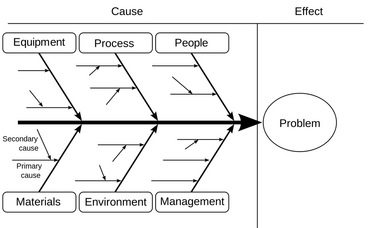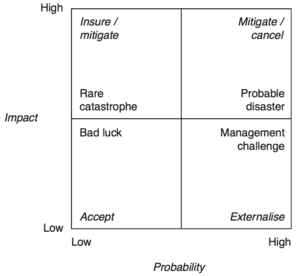Decision tree
Abstract Decision Tree as a tool in Risk Management. [1]
When the risks have been identified and the respective impacts and probabilities have been investigated, the decision whether to insure, mitigate, accept or externalise the risk in question will result in different possible outcomes with different probabilities and consequences. From these different branches other risk decisions will be made, and in the end a decision tree with all the possible different paths to what risks will be managed and how, will be established.
This wiki article investigates how the decision tree works as a tool in risk management, what the benefits are and what barriers are related to this tool.
1. The Decision Tree Concept
2. Applying the Decision Tree to Project Management
3. Other Risk Management Tools Involved
4. Benefits and Possibilites
5. Limitations and Barriers
6. Conclusion
7. References
8. Annotated Bibliography
Writer: Frederik Lind, s133570
Initial Steps to Decision Making
Risk Identification
The identification of risks is a process that must begin early in the project during the planning phase and it must be done thoroughly to mitigate potential delays, change of scope, budget overruns and quality loss.[2]
While the definition of the term risk involves only the possibility of experiencing unfavorable events, risk identification within the project context however both includes the opportunities (positive outcomes) and the threats (negative outcomes).[3]
It is practically impossible to identify all risks before they occur, however it is possible to map an extensive majority through a combination of a number of identification methods.
A common first step to identifying risks is to organize the possible risks in branches of causes, Figure 1.

A list of risks can be gathered through brainstorming in collaboration with the project team, experts and stakeholders by focusing on what possible events and their sources within each branch that will affect changes in scope, cost, time and quality of the outcome of the project.[4]
Risk Assessment
The next step is to assess the potential risks where the goal is to define the consequence and likelihood ranges for each risk source in collaboration with the stakeholders. A tool to visually map the respective probabilities and impacts for each risk and to get an immediate overview of desired response approach is to apply the Probability/Impact Matrix, Figure 2.[1]

When the probabilities and levels of impact have been evaluated, the planning team should be divided into different field-specific sub-groups to which the respective related risks should be assigned.Cite error: Closing </ref> missing for <ref> tag
Cite error:
<ref> tags exist, but no <references/> tag was found